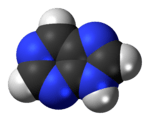Purine facts for kids
Quick facts for kids Purine |
|
|---|---|
 |
|
 |
|
 |
|
| IUPAC name | 9H-purine |
| Except where noted otherwise, data are given for materials in their standard state (at 25 °C, 100 kPa) | |
Purines are important chemical compounds. They are a key part of DNA and RNA, which are the blueprints for life. Think of them as tiny building blocks inside your body.
A purine is a special type of organic compound. It has a ring-like structure made of carbon and nitrogen atoms. This structure is formed by two smaller rings joined together: a pyrimidine ring and an imidazole ring. Purines are very common in nature. They are found in all living things.
Purines and pyrimidines are the two main groups of nitrogen-containing bases. These bases are essential parts of nucleotides, which are the basic units of DNA and RNA.
Contents
What Are Purines?
Purines are a type of heterocyclic compound. This means their ring structure contains at least two different kinds of atoms. In purines, these are carbon and nitrogen. They are also aromatic, which gives them special stability.
These compounds play many vital roles in your body. They help store and use energy. They also help send signals between cells.
Types of Purines
There are many different purines. Some of the most well-known ones include:
- Adenine: This purine is one of the four main bases in DNA and RNA. It always pairs with thymine in DNA.
- Guanine: This is another main base found in DNA and RNA. It always pairs with cytosine.
- Hypoxanthine: This purine is formed when adenine breaks down.
- Xanthine: This purine is formed when guanine breaks down. It can also be found in foods like coffee and tea.
Why Are Purines Important?
Purines are super important for life. Here's why:
- Genetic Material: Adenine and guanine are the "A" and "G" in the DNA code. They carry the genetic information that makes you who you are.
- Energy: A molecule called ATP (adenosine triphosphate) is made from adenine. ATP is like the energy currency of your cells. It powers almost everything your body does.
- Signaling: Some purines act as messengers. They help cells talk to each other. This is important for things like muscle movement and brain function.
Where Are Purines Found?
Your body makes its own purines. You also get them from the food you eat. Foods high in purines include:
- Meat, especially organ meats like liver
- Seafood, like anchovies and sardines
- Some vegetables, like asparagus and spinach
When your body breaks down purines, it produces a substance called uric acid. Usually, your kidneys remove uric acid from your body.
See also

- In Spanish: Purina para niños

